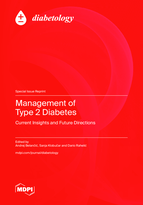Management of Type 2 Diabetes: Current Insights and Future Directions
A special issue of Diabetology (ISSN 2673-4540).
Deadline for manuscript submissions: closed (31 October 2023) | Viewed by 20039
Special Issue Editors
2. Department of Basic and Clinical Pharmacology with Toxicology, Faculty of Medicine, University of Rijeka, Braće Branchetta 20, 51000 Rijeka, Croatia
Interests: clinical pharmacology; diabetes; evidence-based medicine; metabolic syndrome; obesity
Special Issues, Collections and Topics in MDPI journals
Interests: diabetes; obesity; endocrinology
2. School of Medicine, Catholic University of Croatia, 10000 Zagreb, Croatia
3. School of Medicine, Josip Juraj Strossmayer University of Osijek, 31000 Osijek, Croatia
Interests: endocrinology; diabetes; metabolic diseases; diabetes and nutrition
Special Issues, Collections and Topics in MDPI journals
Special Issue Information
Dear Colleagues,
In the Special Issue titled “Management of type 2 diabetes – Current insights and future directions”, edited by Belančić A., Klobučar S. & Rahelić D., a discussion on current novelties and future directions in the (co)management of type 2 diabetes (e.g., digital solutions to improve medication adherence, gut microbiome modification, predictors for successful GLP-1RA treatment outcome, dyslipidemia management, psychological and QoL aspect, etc.), ongoing pharmacoeconomic and reimbursement obstacles (with potential solutions and recommendations), as well on the importance of providing adequate teaching (of students and early career doctors) on antihyperglycemic prescribing, and many more topics, will be provided …
As the field of diabetology is full of novelties, with numerous management and therapeutic innovations, we deliberately chose to discuss those which are currently improving or will improve the current management of the disease. This is especially important since we all know that diabetology is a growing field with constant upgrades in innovations, so it is highly important to stay up to date with all the novelties.
Thus, we believe that the Diabetology is an excellent platform to support such an overview on current evidence and insights regarding novelties in the diabetology management field that we are currently facing or will soon face.
We hope that our Special Issue will draw the attention of the readers and clinicians in general.
If you would like to publish your article (that fits the scope of the aforementioned Special Issue), feel free to contact the editors (e.g., e-mail: a.belancic93@gmail.com) or some of the Editorial Board members of the Diabetology journal. We are looking forward to our potential collaboration.
Dr. Andrej Belančić
Dr. Sanja Klobučar
Dr. Dario Rahelić
Guest Editors
Manuscript Submission Information
Manuscripts should be submitted online at www.mdpi.com by registering and logging in to this website. Once you are registered, click here to go to the submission form. Manuscripts can be submitted until the deadline. All submissions that pass pre-check are peer-reviewed. Accepted papers will be published continuously in the journal (as soon as accepted) and will be listed together on the special issue website. Research articles, review articles as well as short communications are invited. For planned papers, a title and short abstract (about 100 words) can be sent to the Editorial Office for announcement on this website.
Submitted manuscripts should not have been published previously, nor be under consideration for publication elsewhere (except conference proceedings papers). All manuscripts are thoroughly refereed through a single-blind peer-review process. A guide for authors and other relevant information for submission of manuscripts is available on the Instructions for Authors page. Diabetology is an international peer-reviewed open access quarterly journal published by MDPI.
Please visit the Instructions for Authors page before submitting a manuscript. The Article Processing Charge (APC) for publication in this open access journal is 1200 CHF (Swiss Francs). Submitted papers should be well formatted and use good English. Authors may use MDPI's English editing service prior to publication or during author revisions.








